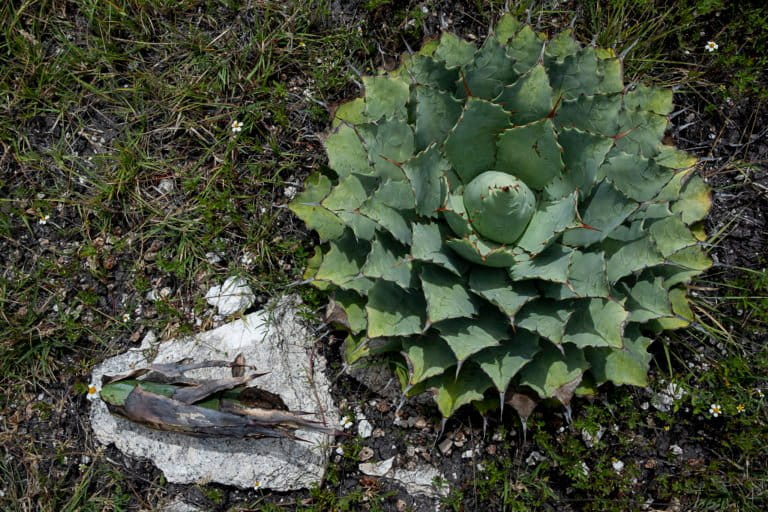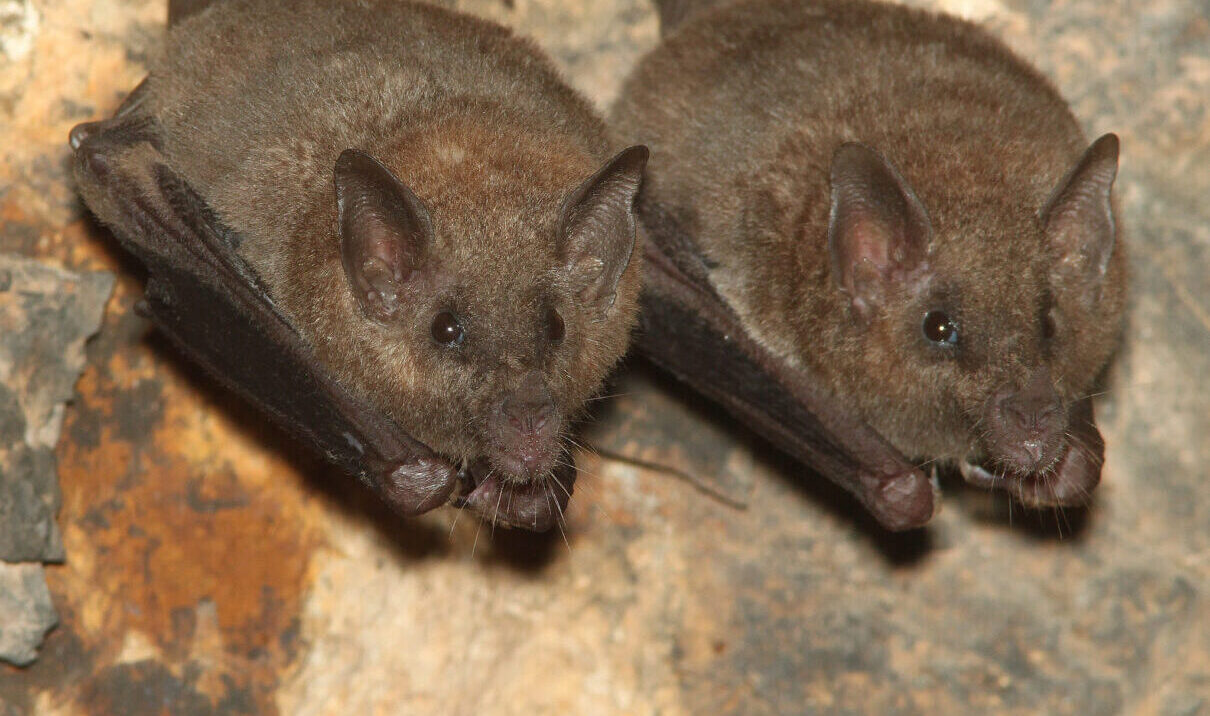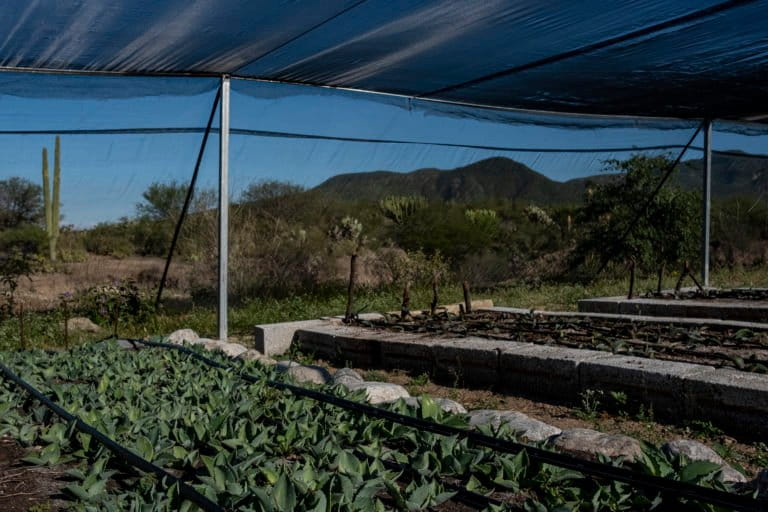- Mezcal, an increasingly popular Mexican liquor, has seen a 700% increase in production in the last ten years, leading to the over-harvesting of wild agave and the expansion of monoculture plantations which ecologists say is threatening endangered bat species and ecosystems.
- Scientists from universities across Mexico are researching how to develop sustainable organic plantations in five states that can meet rising global demand while also benefiting local communities.
- In one of the projects, they are testing over 45,000 thousand agave plants of two native species in agroecological systems to observe which practices best support their growth.
- Because few studies have been done on the environmental impacts of the booming industry, regional studies are needed, says a biologist.
TEHUACÁN-CUICATLÁN BIOSPHERE RESERVE, Mexico — The palenques, or local mezcal production sites, in the village of Santa María Ixcatlán stand unusually empty before the local Day of the Dead celebrations.
“Due to a lack of mature agave left [in the wild], men don’t produce as much mezcal as they used to anymore,” explains the president of the local secretariat of community resources, Andres Herrera. He guides us through one of the village’s empty palenques in the Tehuacán-Cuicatlán Biosphere Reserve, a UNESCO site reputed as a desert biodiversity hotspot with one of the world’s highest concentrations of cacti.
For the past two centuries, local Ixcatec people in the southern state of Oaxaca have made a living producing mezcal, a liquor which, like tequila, is derived from the fermented juices of ripe agave cores. Producers used to extract a native agave species, Agave Potatorum, also known as tobalá or papalometl, from the areas close to the village to produce their local variety of the strong liquor. Tobalá is one of the nine most common agave species used to make mezcal.


But with the skyrocketing global popularity of mezcal, planting, collecting and producing mezcal has boomed across the country. In 2021, the country produced more than 8 million liters of certified mezcal, an approximate 700% increase from ten years ago. Most of this mezcal, about five million liters per year, is designated for international markets — becoming a growing part of mixology culture from bars in New York to bistros in London to cocktail lounges in Shanghai. In Oaxaca alone, where 85% of mezcal is produced, 25,000 families rely on its production for at least part of their livelihoods.
To meet the global demand, producers in various states of Mexico are over-harvesting wild agave and expanding monoculture plantations. According to Alfonso Valiente, an ecologist at the Institute of Ecology at the National Autonomous University of Mexico, this is putting pressure on local ecosystems by shrinking the genetic diversity of agave, threatening bats reliant on the succulent species and increasing deforestation.
Today, the tobalá species is rare near Santa María Ixcatlán and is classified as vulnerable by the IUCN. “Now, we have to walk for hours to the mountain to find the agave,” says Herrera. Agave takes seven to even more than 30 years to mature, which is one of the reasons why it is difficult to recover a species’ population quickly.
In response to their environmental concerns, Valiente and a team of over sixty scientists backed by their respective universities are running a research project across five states in Mexico along with local producers. This collaboration between researchers and farmers started in San Juan Raya, another village in the biosphere reserve, and is currently co-funded by the Mexican National Council for Science and Technology (CONACYT).
The project aims to develop organic polyculture plantations to meet global demand for mezcal production in a way that ensures biodiversity conservation and rural development. They intercrop native agave in an agroecological system that mimics its natural habitat of diverse columnar cacti, legume shrubs, and other agave species.
Environmental concerns
According to Mexico’s Regulatory Council for Mezcal Quality, a certification body that certifies 98% of all certified mezcal, there are 5,659 terrains where mezcal is harvested officially and legally, totaling about 30 million agave plants on over 65,000 hectares (over 165,000 acres) in nine states. The majority of these are grown in monoculture plantations.
The Lesser long-nosed bat (Leptonycteris yerbabuenae), which was listed as endangered in Mexico between the 80s and 2015, is the most important pollinator of several agave species, including that of tequila and tobalá, requires the nectar from agave flowers to cross-pollinate agave and columnar cacti, which produces fruit feeding dozens of animal species. However, mezcal producers, both when collecting wild agave and cultivating monoculture plantations, extract the heart of the plant right before it blossoms as this is when there is the highest amount of sugar present, which is necessary to produce the liquor.
“This reduces the availability of floral resources, like nectar and pollen, that feed the bats during their migration route in Mexico,” says Valiente. “Even lowering the density of wild agave would affect the bat population and thus create a domino effect on local ecosystems and biodiversity. This can happen very fast.”

Valiente warns that the diminishing bat population can impact other species. “There are species that are pollinated by one specific bat species. The most important pollinator of some agave plants is the lesser long-nosed bat that also pollinates columnar cacti, like Neobuxbaumia tetetzo.”
“And one hectare of a cacti forest feeds about 119 species of animals,” says Alfonso Valiente.
Although it is difficult to know the exact population of bat species, it has been challenging to recover the population of some, such as the Mexican Long-nosed bat (Leptonycteris nivalis), which also pollinates certain agave species, according to Rodrigo Medellín, who is an expert on bats from the National Autonomous University of Mexico. He is also behind the project Bat Friendly which encourages liquor producers to leave 2-5% of agave in their fields to blossom.
Ecologists also worry Oaxaca is experiencing deforestation for espadín agave (Agave Angustifolia), the most common agave extracted for mezcal, found in vast monoculture plantations, and for cooking fuel.
Though the number of agave plantations grows each day and it is hard to know the exact area deforested due to them, Valiente says. Little recent data on deforestation driven by mezcal plantations exist. For example, between 2000 and 2012, in Matatlán, a well-known mezcal production area, 35.7% of the producers extended agricultural land to the hillsides for agave cultivation, and in El Camarón, 55.7% of producers did so.

“The issue of (cutting down) hardwood is important and rarely studied. It is a problem in terms of the forest management and overexploitation of forest ecosystems,” says Larson Guerra, a biologist at the National Commission for the Knowledge and Use of Biodiversity.
“To really understand the situation of the ecosystems and the pressure exerted on them, it is necessary to carry out regional studies and keep them relatively updated, perhaps every five years. But the support to generate up-to-date and regionally valid information has not been sufficient,” states Larson Guerra.
Read more: Mexico devises revolutionary method to reverse semiarid land degradation
Incubating a sustainable plantation
In San Juan Raya, Valiente and other scientists hope their research project will inform sustainable plantations in the region by using agroecological systems.
Eight years ago, they first established a nursery surrounded by mesh to ensure the survival of the seedlings from predators. Planted in rows are now about 45,000 young agave plants, the two native species of this place, Agave Potatorum and Agave Marmorata.
Unlike monoculture plantations, where plants reproduce by shoots (small plants that are born at the base of the stems), which are replicas of the main plant, community members here collect the seeds. One agave usually produces thousands of seeds. They plant them in the shade for protection during their first years.

At the side of the nursery are bags made of corn holding thousands of three-year-old agave seedlings. The community members and scientists plant these seedlings in a chosen area of the biosphere reserve near other plants and agave species.
As the sun sets on the peaks of the hills and canyons of the reserve, Alfonso Valiente guides us through one of two plots in their plantation designated to grow. As of last December, about 8,000 agave plants have been transplanted. Approximately 2,300 of them are marked with numbers to observe which other plants support the growth of transplanted agave.
“What we have noticed until now is that if you plant agave where there is an empty space and no supportive plants around, it dies more easily,” Valiente explains. “Agave grows better if the surrounding plants are genetically diverse.”
According to the latest research, the best plants to plant agave around are legume shrubs, such as e.g. Mimosa Luisana, a nitrogen-fixing plant that supports nitrogen in soil with the help of bacteria.
“We’ve had no problems with plagues here so far,” Valiente adds.

In agreement with communities that participate across Mexico, up to 30% of the agave plants will be left in the polyculture plantations to nourish bats and other animals dependent on the nectar and pollen of the agave flowers. The other 70% will be sold for mezcal production.
However, as this is a long-term project without immediate economic returns, this also makes a lot of local producers, like those in Santa María Ixcatlán, reluctant to embark on the project.
In San Juan Raya, they still need to wait at least two more years for the agave to mature. The plan is to create palenques that produce mezcal or sell outside the village. Valiente told Mongabay that they are searching for the best ways for the community to benefit from growing agave. Each participating community has its own plans.
Plantations similar to the ones in San Juan Raya are being prepared in Guerrero, Tamaulipas, and Sonora. Valiente and other scientists are now campaigning in Oaxaca to get more communities involved in their project.
So far, on a federal level, no policy enforces sustainable growth and extraction of agave plants. However, laws have been passed in some states, like Hidalgo, the state of Mexico and Tlaxcala, which have passed their own laws protecting the diversity of agave and ecosystems. The law of the state of Hidalgo, for example, mentions the intention to support programs that improve the genetic diversity of agave, the importance of capacitation of those who grow agave sustainably and a search for funding for sustainable cultivation.

In various Mexican states, mezcal producers have also been searching for solutions to protect ecosystems as the demand for local liquors is growing. In Oaxaca, Guerrero, or even Jalisco—a state famous for its tequila production—some families and companies are exploring the management of agave in forests and ways to protect landscapes where it grows.
“The ministry of environment and the National Forest Commission have shown openness in including forest management of agave in various regions, particularly Durango, Guerrero and certain regions of Oaxaca,” says Larson Guerra.
“This is very important since it sets the precedent that a wild population can be studied to establish a management plan and use of agave for mezcal.”
Banner image: People in San Juan Raya decided to join a research project to grow agave for mezcal sustainably. Image by Noel Rojo for Mongabay.
Related listening from Mongabay’s podcast: We discuss a massive new railway project, the Maya Train, in Mexico. Listen here:
Indigenous agroforestry dying of thirst amid a sea of avocados in Mexico
FEEDBACK: Use this form to send a message to the author of this post. If you want to post a public comment, you can do that at the bottom of the page.













